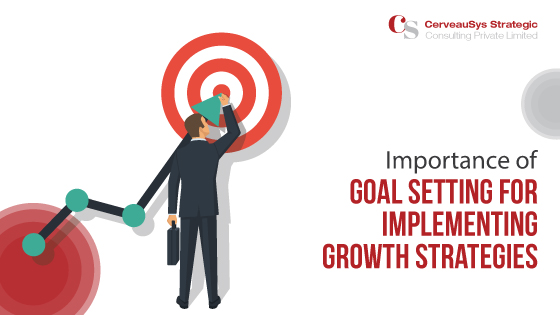The Importance of Goal Setting for Implementing Growth Strategies in Organizations
Have you ever wondered why some organizations consistently achieve their growth targets while others struggle to make progress? The answer lies in the power of goal setting. Clear goals act as a guiding force, helping businesses focus on what matters most, align resources, and execute strategies effectively.
At CerveauSys Strategic, a leading strategy and management consulting firm in Pune, we believe that without defined objectives, even the most ambitious growth plans can falter due to a lack of direction or purpose. In this blog, we’ll dive into the importance of setting goals and explore how they serve as the backbone of successful growth strategies for organizations. Let’s get started.
The Need for Goal Setting in Organizations
1. Aligning Organizational Vision with Strategic Goals
Organizational success begins with a clearly defined vision. However, without specific goals, that vision remains abstract and unattainable. Strategic goal setting translates an organization’s overarching vision into measurable objectives that employees at all levels can understand and work toward. When goals align with the vision, teams are more motivated, and decision-making becomes more focused and effective.
For example, a company striving to become a market leader must set quantifiable benchmarks, such as achieving a specified market share within a defined timeframe. A well-aligned goal-setting process ensures that every strategic initiative contributes directly to the organization’s ultimate purpose.
2. Prioritizing Resources for Maximum Impact
Goal setting is essential for effective resource allocation. Organizations often have finite resources in terms of time, talent, and capital, which must be directed toward the most impactful initiatives. By setting clear growth-oriented goals, businesses can prioritize efforts to ensure that resources are used optimally.
For instance, a company aiming to grow its market presence may prioritize marketing campaigns, partnerships, or investments in sales teams. On the other hand, a focus on innovation may demand the channeling of resources into R&D projects. Structured goal setting provides clarity, avoiding waste and inefficiencies, while empowering teams to maximize results.
3. Creating a Roadmap for Actionable Strategies
Setting goals provides organizations with a roadmap for achieving their strategic aspirations. Without clear objectives, teams can easily lose direction or work toward competing priorities. By defining step-by-step goals, businesses can create actionable strategies that break down larger objectives into manageable tasks.
For instance, an organization aiming to enter a new international market may set preliminary goals such as market research, regulatory approval, and building local partnerships before launching its products. A well-structured roadmap not only enhances focus but also ensures that strategies are implemented in a logical, sequenced manner, reducing the risks of mismanagement.
4. Enhancing Communication and Collaboration
Clear goals serve as a common language across departments, helping align teams and foster collaboration. When individual team members and departments understand how their roles contribute to the organization’s growth strategy, they are better positioned to work cohesively toward shared objectives.
For example, achieving a revenue growth target might require cooperation among sales, marketing, production, and customer service teams. Goal setting ensures that everyone remains on the same page, minimizing conflicts and fostering interdepartmental synergy. Additionally, regular communication about progress toward goals enhances transparency and reinforces trust within the organization.
5. Driving Employee Engagement and Motivation
Goal setting is not just a tool for management—it also plays a significant role in inspiring employees. Clear organizational goals give employees a sense of purpose and direction, ensuring that their efforts contribute meaningfully to the company’s growth. When employees know what is expected of them and can see how their contributions drive progress, they are more likely to stay motivated and committed to their roles. For example, recognizing employee achievements tied to specific goals can boost morale and encourage a culture of accountability. This enables organizations to maintain long-term productivity and employee satisfaction.
6. Fostering a Culture of Accountability
Accountability is critical when implementing growth strategies, and goal setting provides an essential framework for measuring success. By establishing clear timelines, milestones, and performance metrics, organizations can track progress and ensure that each team member is accountable for their responsibilities.
For example, assigning specific revenue targets to sales teams or market reach goals to marketing departments creates a structure for assessing performance. This culture of accountability ensures transparency and encourages individuals to take ownership of their contributions, which is essential for driving sustainable growth and addressing any gaps in execution early on.
7. Measuring Progress and Adjusting Strategies
Growth strategies rarely proceed exactly as planned, and this is where goal setting becomes invaluable. Defined goals allow organizations to measure their progress, assess what is working, and identify potential roadblocks. Ongoing evaluation against goals—using metrics such as KPIs (key performance indicators)—enables businesses to adapt and refine their strategies in real time.
For example, if a company’s goal to reach 10% market growth stagnates mid-year, it can review its marketing efforts or adjust pricing strategies to address challenges. The ability to measure progress and course-correct ensures that organizations stay on track, even in the face of uncertainties.
8. Encouraging Innovation and Risk Management
Goal setting encourages organizations to think creatively about how they can achieve their objectives, spurring innovation in processes, products, and services. For instance, a company focused on customer retention could explore innovative loyalty programs or automation to improve service delivery.
Additionally, goal setting enables organizations to proactively assess risks and devise contingency plans as part of their strategic framework. Setting goals forces organizations to evaluate potential barriers or obstacles, ensuring that they are prepared to address challenges while pursuing growth. This combined focus on innovation and risk management allows businesses to thrive in competitive landscapes.
9. Boosting Competitive Advantage
In today’s competitive markets, having clear goals can be a significant advantage. Organizations that set and achieve concrete goals are better positioned to outperform rivals who may lack a structured growth strategy. Goal setting provides businesses with a unique edge by helping them stay focused, leverage resources effectively, and respond quickly to industry changes.
For example, a company aiming to launch a product before competitors can establish clear development deadlines and promotional campaigns to secure its first-mover advantage. Well-defined goals empower organizations to anticipate challenges, seize opportunities, and continuously differentiate themselves in the marketplace.
10. Sustaining Long-Term Growth
Finally, goal setting is vital for ensuring long-term organizational growth and sustainability. Achieving growth in one phase of business development is not enough; companies must also prepare for future challenges and opportunities. By setting short-term, mid-term, and long-term goals, organizations can create a balanced growth strategy that supports ongoing progress while mitigating the risks of stagnation.
For example, a company might focus on strengthening customer relationships in the short term, achieving brand recognition in the mid-term, and diversifying product offerings over a longer timeframe. This strategic layering of goals ensures that growth is both sustained and adaptable over time.
Unlock Organizational Growth with Goal Setting
Overall, goal setting is a fundamental component of implementing successful growth strategies in organizations. By tracking progress, promoting innovation, and addressing risks, well-defined goals empower businesses to navigate challenges and capitalize on emerging opportunities. Ultimately, organizations that prioritize structured goal setting are better equipped to sustain long-term success in today’s competitive marketplace.
Partnering with the right strategy and management consulting firm in Pune, like CerveauSys Strategic, can make all the difference in achieving these goals.
We are a leading name in the field, providing unmatched expertise in crafting and executing growth strategies tailored to individual organizational needs. Renowned for our deep industry insights, customized solutions, and a results-driven approach, we can help your business thrive.
Ready to set your goals and achieve them? Discuss with CerveauSys Strategic today!



